Breast cancer continues to be one of the most commonly diagnosed cancers worldwide, affecting millions of women—and men—each year. Despite the sobering statistics, the global effort to raise awareness and encourage early detection has made a significant impact. Breast Cancer Awareness campaigns, particularly those during Breast Cancer Awareness Month in October, have not only educated the public but have also shaped health policies, promoted research, and provided support to survivors and families.
In this article, we’ll explore why breast cancer awareness is more important than ever, how public interest influences outcomes, and what can be done to maintain and grow momentum in the fight against this disease.

What is Breast Cancer Awareness?
Breast cancer awareness refers to efforts made by individuals, organizations, and governments to inform people about breast cancer symptoms, risks, prevention methods, and treatment options. The goal is to encourage regular screenings, promote early detection, and reduce stigma around the disease.
Why Awareness Matters
Early detection of breast cancer significantly increases survival rates. According to the World Health Organization (WHO), when breast cancer is detected early and treated promptly, the five-year survival rate exceeds 90%. Unfortunately, in many parts of the world, late-stage diagnosis remains common due to a lack of awareness and access to medical resources.
Breast Cancer Awareness campaigns work to bridge this gap through:
- Public education campaigns
- Free or subsidized mammogram screenings
- Support groups for patients and survivors
- Research funding initiatives
The Impact of Breast Cancer Awareness Month
A Global Movement Every October
Breast Cancer Awareness Month, held annually in October, is the centerpiece of global awareness efforts. Recognized by the symbolic pink ribbon, this month sees a surge in fundraising events, media coverage, and educational campaigns. It is a time when brands, celebrities, healthcare providers, and advocacy groups unite under a common cause.
During October, search interest for “breast cancer” increases significantly, according to Google Trends. This spike in search volume indicates that public interest is not only high but growing, especially as awareness expands to digital platforms like YouTube, Instagram, and TikTok.
Media and Marketing Power
Companies often roll out pink-themed products and donate a portion of profits to breast cancer research. While “pinkwashing” has been criticized when marketing overshadows genuine contribution, many campaigns have successfully raised millions of dollars and inspired wide-scale behavioral change.

Public Figures and Their Role in Awareness
The impact of celebrities and influencers in raising breast cancer awareness cannot be overstated. When public figures share their stories, the message reaches audiences who might not otherwise engage with health campaigns.
For example, media coverage around Christina Applegate, Shannen Doherty, or Julia Louis-Dreyfus discussing their breast cancer experiences has led to increased screening appointments and heightened awareness about symptoms and treatment. These stories personalize the disease and break down barriers of fear and stigma.
The Digital Age of Awareness
Social Media as a Health Education Tool
Platforms like Instagram, Facebook, and Twitter have become powerful tools for spreading breast cancer awareness. Campaigns like #NoBraDay, #ThinkPink, and #BreastCancerAwareness gain millions of impressions each year, reaching people across all age groups and demographics.
User-generated content—such as survivor stories, mammogram reminders, or educational infographics—can go viral, further normalizing conversation around breast health.
The Rise of Health Influencers
With the growth of wellness and health influencers, social media has birthed a new wave of awareness strategies. These influencers can simplify medical jargon, share personal experiences, and offer emotional support—all of which help demystify the disease for younger audiences.
Barriers to Awareness and Access
Despite the progress, many barriers still hinder breast cancer awareness and prevention efforts:
- Cultural stigmas around discussing women’s health issues
- Limited access to screening services in rural or low-income communities
- Lack of insurance coverage for mammograms in some countries
- Misinformation spread online
To combat these issues, awareness campaigns must be inclusive, culturally sensitive, and data-driven. Governments and healthcare providers must also invest in infrastructure that allows early detection and timely treatment to become the norm, not the exception.
How You Can Contribute to Breast Cancer Awareness
Even as an individual, you can make a difference in raising awareness. Here’s how:
- Educate yourself and others: Learn about the symptoms and risk factors.
- Share resources: Post informative content on social media.
- Support survivors: Listen, donate, or volunteer with local organizations.
- Get screened: Encourage regular mammograms for yourself and loved ones.
- Join awareness events: Participate in walks, runs, or community fundraisers.
Conclusion: Keeping the Momentum GoingBreast cancer awareness has come a long way in recent decades, but the work is far from over. With early detection as the most powerful tool in reducing mortality rates, maintaining high levels of public interest and awareness is critical. By harnessing the power of community, media, technology, and education, we can continue to empower individuals to take control of their breast health.
Remember: awareness isn’t just for October—it’s a year-round commitment to saving lives, supporting one another, and striving for a future where breast cancer is no longer a life-threatening diagnosis.